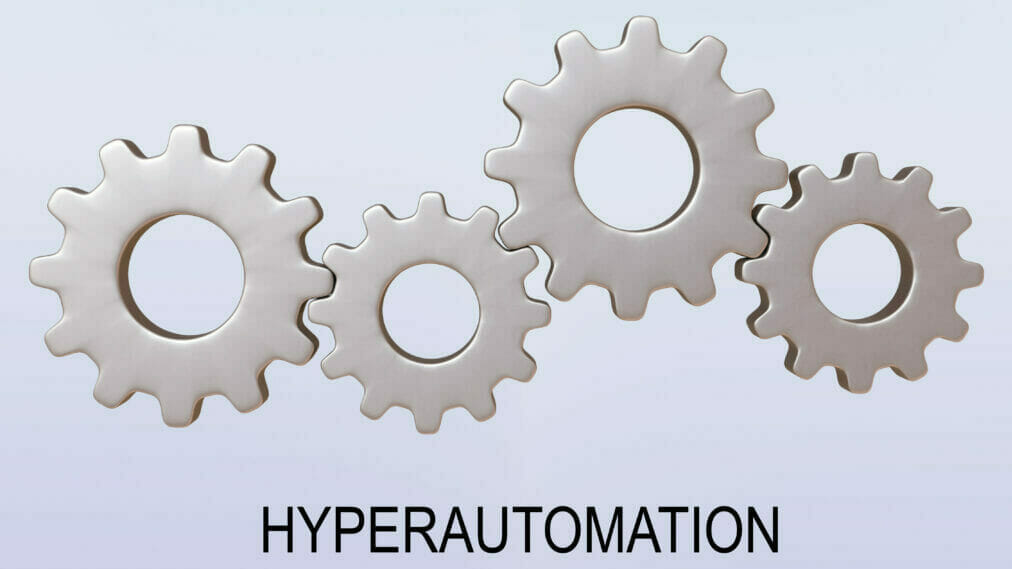In its 2019 report ‘Move Beyond RPA to Deliver Hyperautomation’, Gartner pointed out a lack of guidance in how organisations should integrate robotic process automation (RPA) with other tools. The report also highlighted that business managers experience pressure to focus on automating simple routine procedures, but lack a strategy to turn siloed automation processes into something that extends to the whole factory.
The solution, according to the global research company, is hyperautomation, defined as end-to-end automation that combines complementary technologies and artificial intelligence to augment business processes.
See also: The hottest hyper-automation trends disrupting business today
Hyperautomation brings together multiple solutions such as deep learning, advanced analytics, machine vision, natural language processing and RPA to automate complex processes, rather than individual tasks. This allows business managers to tackle bigger challenges and focus on a long-term optimisation strategy.
Worldwide hyperautomation-enabling software market to reach nearly $600 billion by 2022 — Gartner
How is it different from automation?
The main difference between traditional automation and hyperautomation is that the former tends to focus on automating specific processes — such as deploying a cobot rather than a human worker for repetitive pick and place applications — while the latter aims to optimise the whole production process with a holistic approach.
For example, to reduce the cost of poor quality, plant managers might decide to implement an Autonomous Machine Vision system to spot defected items on the production line. This is a quick, easy and cost-effective way to ensure thorough quality checks without having to rely on human inspectors. However, this doesn’t tackle the root of the problem, which is preventing defects from happening in the first place.
To do this, manufacturers might use several quality assurance (QA) stations along the production line, and integrate an AI-based solution to analyse the results of the QA process. This will allow them to perform root cause analysis and understand where defects occur more frequently and why, and to invest in automated solutions that might keep the problem at bay. For example, once established that paint defects are regularly happening because of an excess of airborne debris, an automotive manufacturer might decide to implement an automated humidification system. This could be coupled with smart sensors to activate only when the level of airborne contaminants has risen above a tolerable threshold.
In this example, several automated tools are used in combination to tackle a challenge end-to-end. Manufacturers can create several of these ecosystems to maximise the efficiency of every aspect of production, from order acquisition to final delivery. Crucially, these systems must be able to communicate with each other to achieve a smooth workflow and guarantee the best results.
A guide to modern factory automation and Industry 4.0 in manufacturing
Do I need it?
Gartner predicted that hyperautomation would be one of the top strategic technology trends from 2020 onwards, but that doesn’t necessarily mean that manufacturers must buy into the hype. The first thing to do to understand whether end-to-end automation can deliver substantial business value, is to create a roadmap that clearly aligns business goals with the automation tools needed to reach them.
Gartner suggests considering three key objectives — revenue, costs and risks. According to these parameters, manufacturers might want to think about which technologies can drive revenue by enhancing customer engagement, increasing output, and automating repetitive tasks. They should then redesign processes to reduce the cost of poor quality and streamline production. Finally, they might need to consider the compliance risks of inefficient processes — for example, feeding parts to a machine manually might be not only inefficient but also risky, and it might therefore violate safety regulations.
A careful consideration of these factors should give manufacturers a clearer idea of whether or not hyperautomation can significantly boost productivity and give them the competitive edge they might be lacking without it.
Why RPA is a game changer in the post-Covid era
What about legacy equipment?
Hyperautomation is based on the latest automation technologies available, as well on their ability to intercommunicate flawlessly. As a result, manufacturers might think that it is not a viable business approach for factories that use legacy equipment for critical applications.
Machines that form the backbone of factory automation, such as programmable logic controllers (PLCs), might last several decades, and there’s no reason to replace them if they still perform adequately and comply to the most recent guidelines. However, legacy equipment usually lacks the communications capabilities required to implement a hyperautomation strategy.
Although this might involve an extra layer of planning, the use of legacy machinery doesn’t necessarily mean that automating end-to-end is out of the question. If plant managers manage to develop a solid business case for hyperautomation, there are ways to retrofit older equipment with smart sensors. In this way, the machines can be connected the to the Industrial Internet of Things (IIoT) and send valuable data that can be used to streamline operations, reduce costs and increase productivity. An automation parts supplier that specialises in obsolete equipment can easily provide manufacturers with the hardware they need to retrofit their machines and make them fit for Industry 4.0.
Another thing to consider is whether IoT-connected machines will speak the same language. For example, the factory’s PLC needs a communication protocol that is compatible with the field devices. Manufacturers don’t necessarily need a protocol from the same brand of their PLC — for example, ProfiBus can connect with all PLCs from the Allen Bradley family, but some protocols do not play well with others. This means that to implement hyperautomation, manufacturers will have to research the best protocols to make sure that all their equipment can communicate.
When possible, developing systems based on an open-source architecture — such as the Robot Operating System (ROS) — rather than proprietary software, can help minimise frictions and ensure interoperability.








